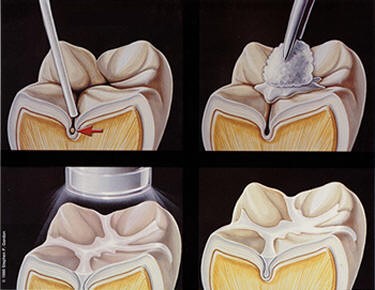The Sealant Process
Sealants, what are they?
Tooth sealants (dental sealants) are a plastic coating that’s bonded into the grooves of teeth. Their purpose is one of helping to prevent cavities.
Who should get them?
While placing sealants is typically associated with children, any at-risk tooth, no matter the age of the person, can and should receive one. This procedure is typically a very cost-effective preventive measure.
How do they work?
A sealant creates a smoother tooth surface, one that’s easier to clean and therefore more resistant to the formation of decay.
Why are they needed?
Cavities are caused by bacteria that live in dental plaque (the white film that forms on teeth). Tooth brushing helps to prevent decay by scrubbing away this plaque.
Deep tooth grooves can be hard to clean.
Some teeth, especially molars, have grooves (pits and fissures) on their chewing surface and /or sides that are narrow and deep. And in these cases, when the person brushes their teeth, some of the dental plaque that has accumulated on them is left behind.
That’s because the individual bristles of their toothbrush are too large to reach into the depths of their tooth’s pits and fissures (illustrated in our graphic). And because some plaque still remains, the tooth remains at risk for cavity formation.
How does sealant fix this problem?
By bonding plastic resin (the dental sealant) into the grooves of a tooth, a dentist can make a tooth’s surface smoother. As a result, there are no longer any locations where the bristles of a toothbrush can’t reach and clean. The tooth is now at less risk for developing a cavity.

